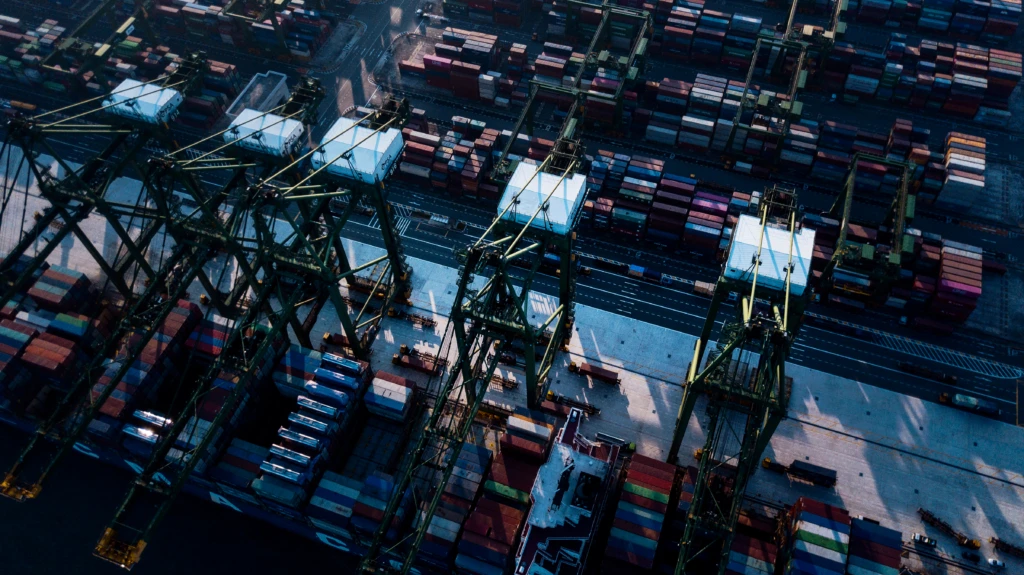
Improve supply chain resiliency, traceability, and predictability with blockchain

Introduction
“Many new technologies have transformed the supply chain industry over the years; however, persistent problems remained, such as lack of traceability, especially for raw materials, and a lack of trust in data across parties. Our team has applied a new blockchain-based solution to solve these and many other supply chain challenges across our cloud hardware supply chain. I am excited about what this new technology is already achieving, and even more excited about what it can achieve in the near future: delivering mine-to-datacenter traceability and significant ongoing cost savings. In this post, Yorke Rhodes explains our team’s blockchain implementation and why it holds unique potential for illuminating the supply chain.”—Cliff Henson, CVP, Capacity, Supply Chain & Provisioning
Microsoft’s cloud supply chain ensures Microsoft can deliver capacity more predictably and at scale to empower our customers to achieve more. The team oversees the entire supply chain process for our datacenters, which includes planning, sourcing, making, and deploying servers, storage, and networking gear as well as decommissioning them at end of life and managing customer capacity.
For decades, a lack of visibility, item-level traceability, and predictability has plagued supply chain operations, even for the companies with the most advanced supply chain management in the world. This leads to overspending, errors, risks of fraud, counterfeits, use of conflict minerals, and more. Microsoft’s blockchain platform is addressing those challenges, and has already uncovered tens of millions of dollars in hidden costs, improved end-to-end item level traceability, reduced cycle time, and expanded margins by digitizing items in a shared data structure.
Learn more about how you can improve your organization’s service resilience and profitability by planning and implementing a more resilient supply chain.
Common problems in the supply chain industry
Across Microsoft’s physical and digital product offerings, there are a myriad of concerns, such as the risk of counterfeit goods entering the supply chain, that have a direct impact to our business and our customers. This issue can be due to improperly licensed copies of Microsoft products showing up on OEM hardware, counterfeit components getting into our own device hardware or servers destined for our cloud datacenters to name a few. Additionally, finding the root cause of component quality issues, quarantining that component in the supply chain and in production, and then removing it is a complex and time-consuming effort. Finally, the difficulty of verifiably identifying the sources of raw materials used to make the components introduces the risk of using conflict minerals. These are among a host of other common issues across the industry.

All supply chains exist in the context of a network of value chain parties. This means reconciling data across those parties, gaining visibility to goods in custody and in movement, and understanding the complex multi-party relationship of those goods, invoices, purchase orders, and rebates are baseline requirements. Transparency and visibility for these processes have been difficult due to the siloed nature or systems thinking among supply chain participants. When each participant is solving a systems problem within the walls of their enterprise, it leads to a fragile network of interconnected systems. As a result, there is no shared view of data across multiple tiers of the supply chain and it is challenging for multiple participants to work from a shared set of business objects. Thus, it requires a massive effort to reconcile these disparate data siloes. The result is a lack of visibility that impedes agility and makes it difficult to improve cost efficiency.
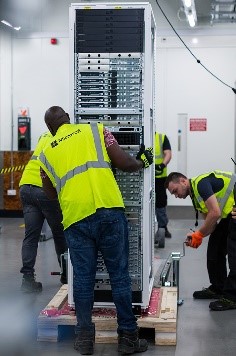
The dream for many supply chain technologists has been a unified platform that allows inventory and financial traceability from the component supplier through manufacturing, shipping, warehouse, and delivery to solve traditional visibility problems in multi-tiered supply chains. Technology is finally ready to tackle this problem, and we’re on a path to demonstrate traceability all the way from the mine to the datacenter and end-of-life disposition, achieving transparency on the responsible sourcing of critical or raw materials.
Supply chain, meet blockchain
Blockchain has distinctive qualities that enable unique item identification, tracking, visibility, and shared logic among multi-tiered supplier relationships across three or more parties. Traditional ERP systems help siloed enterprise systems designers solve for two-party relationships but lose visibility in three or more (n-tier) supplier relationships that are typical in complex supply chains. The data structure of blockchain and n-tier participation in a blockchain network open possibilities previously constrained by current approaches. Due to the immutable nature of the data, blockchain elevates conversations from the morass of data reconciliation to shared business problem solving and unlocks the possibility of shared business logic on that agreed upon data.
Blockchain builds the foundation for digitized supply chain
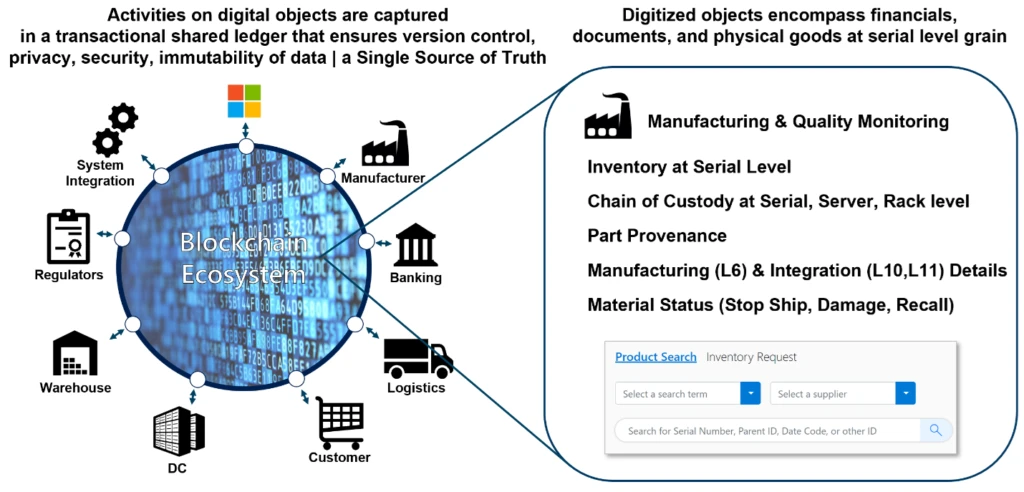
The technology is capable of becoming an industry utility and supply chain data repository providing benefits to all participants, such as unique market data previously unavailable from any source.
Technical implementation
Microsoft envisioned a solution that would help our partners and the industry as much as our own supply chain by creating digital twins of each component tied to sequenced transactions and associated documentation and information. For this reason, Microsoft closely collaborated from the beginning with eight key supply partners—Arrow, Lenovo, Wiwynn, ZT Systems, Micron, and SK hynix, and others—who share Microsoft’s vision of innovative digital transformation in the supply chain. The platform is established around a foundational network consortium of these partners, which ensures benefits, synchronized processes, and technical upgrades across all parties.
Microsoft worked with Accenture to build the blockchain platform as a best-in-class full-stack application on Azure for cloud scale using Azure-first serverless components. Read additional details on Azure architecture components for a full stack blockchain application.
“Accenture envisions the transformation of supply chains from isolated data islands to advanced, secure data networks powered by blockchain. As Microsoft’s strategic service partner we are excited by the opportunity to unlock value to all participants and to scale the network through more components, ecosystem players and use cases.”—David Treat, Senior Managing Director, Tech Incubation, Accenture
The expected outcomes are significant improvements in traceability of inventory from origin, in transport and storage, and at destination in the data center. The solution provides network participants digitization of serialized items and the associated financial and information flows in the form of digitized statements of work (SOWs), invoices, and purchase orders (POs). This lays the foundation for digital transformation capabilities beyond traditional systems such as tokenized payment settlements, reduced risk, and lower credit costs. Transformation in payment and settlement will help to establish a more sustainable and resilient supplier base by improving cashflow and easing financing fees for the smallest suppliers.
With the collaborative focus, Microsoft has formed an ecosystem in which all parties actively participate. Microsoft seeded the project by investing the costs to stand up this consortium and develop the first supply chain material traceability application, creating value for all parties.
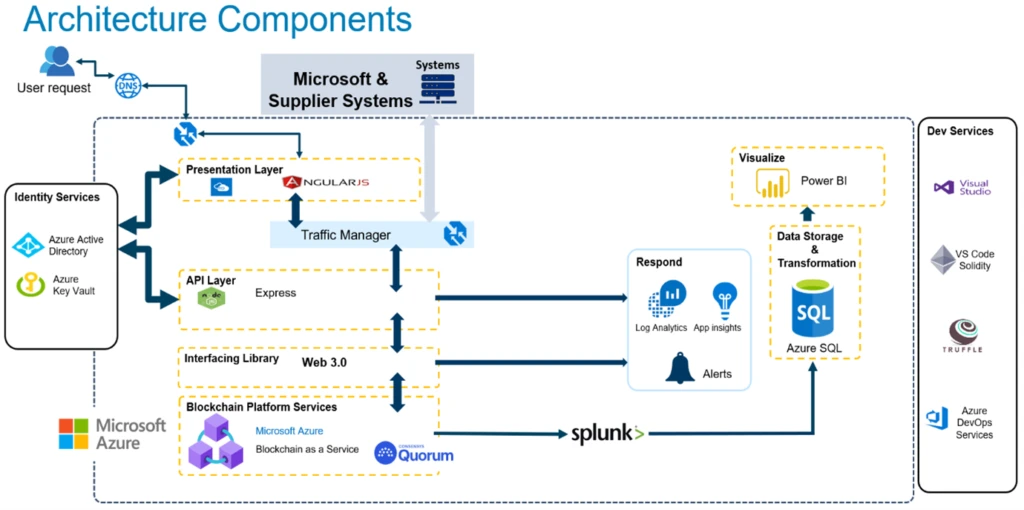
Learn more
We are enthusiastic about the collaboration with our key supplier and technology partners and embarking on the next phase of the journey. To learn more about blockchain in supply chain, check out my keynote at the University of Memphis FedEx Institute of Technology Blockchain Series held on December 3, 2020.
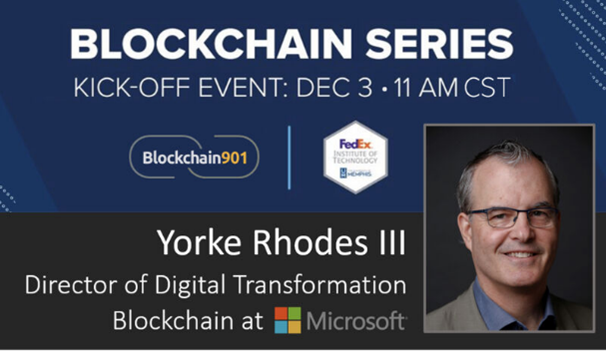
Major supply chain improvements and a happy and healthy consortium
“This is one of the most promising innovations I’ve seen applied to top industry challenges,” said Chuck Graham, General Manager of Microsoft Cloud Sourcing and Supply Chain. “The single, shared data set that enables all parties to view, contribute to, and monitor data is revolutionary in its ability to create trust in the data across all parties. The blockchain platform is already delivering and has saved tens of millions of dollars in hidden costs, improved end-to-end item level traceability, reduced cycle time, and expanded margins by digitizing items in a shared data structure.”
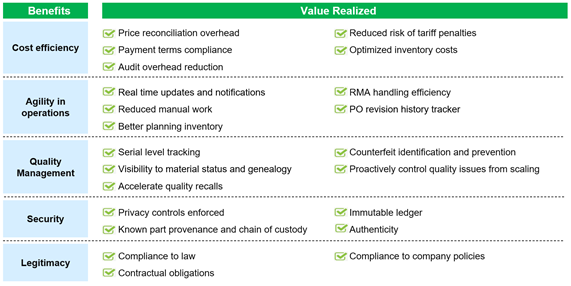
We are excited to see the benefits have been realized not just at Microsoft, but with our broader stakeholders.
Lenovo
“At Lenovo, we are transforming from a functioning supply network to a demand driven value ecosystem that our customers trust. Through the use of Blockchain, we are seeing operational efficiencies and improved transparency and traceability, creating a truly secure and trusted supply chain. We are excited about our collaboration with Microsoft as a preferred partner as this work complements the capabilities built by Lenovo and enhances Lenovo’s transformation strategy. We are excited to see benefits similar to our other blockchain initiatives, both operationally and from a customer experience perspective.”—Renee Ure, Lenovo’s Chief Operating Officer, Vice President Data Center Group
Wiwynn
“As Microsoft’s primary design partner and system integrator for cloud hardware, frequent communication with ecosystem partners is critical to managing manufacturing, delivery, and after service. It’s our pleasure to join Microsoft’s initiative to connect the dots and build the data network with the pioneer blockchain technology. This game-changing, transparent, and trusted platform will realize item-level traceability to enable proactive and dynamic supply chain management and benefit the entire ecosystem.”—Joe Chiao, Wiwynn’s Vice President of Sales and Account Management
ZT Systems
“Microsoft’s blockchain powered platform is a game changer for supply chain management, delivering unprecedented network-level visibility and verifiability for end-to-end material flows. Future applications of this service will enhance and simplify ‘As Built’ supply chain security validation, as well as component-level track and trace throughout the value chain. ZT Systems is pleased to be a leading strategic partner enabling Microsoft’s blockchain solution and realizing their benefits within ZT operations.”—Ike Harris, Vice President of ZT Systems’ Supply Chain Operations
Arrow
“This is an example of Arrow Electronics’ history of and expertise in solving complex global supply chain needs. We are helping the world’s largest OEMs manage the raw components globally into all of their EMS partners. This provides these OEMs the visibility and, most importantly, the control of their supply chain, something that many have been struggling with achieving until now. Arrow’s Global Supply Chain Services can solve these types of challenges given our unique position in the marketplace.”—Alan Bird, President of Arrow’s Global Supply Chain Services
Micron
“At Micron, we are passionate about applying new technology solutions to solve our customers’ needs. Our partnership with Microsoft has underscored the tremendous potential in utilizing blockchain to deliver new efficiency and control to our extended supply chain and entire product ecosystems.”—Anand Bahl, Micron’s Chief Information Officer and Corporate Vice President
Splunk
“While supply chains have been stuck in the industrial age, information travels at the speed of the goods. Microsoft’s cloud supply chain operates in the data age, with full visibility into the transactions, applications, and infrastructure. Splunk looks forward to working closely with Microsoft to bring greater efficiency, transparency and trust using data.”—Nate McKervey, Head of Blockchain and DLT at Splunk
ConsenSys
“Built on ConsenSys Quorum’s enterprise Ethereum, this partnership will provide next-generation solutions to achieve the interoperable exchange of transaction information, transaction history, and transaction statements in compliance with industry standards. We’re thrilled to collaborate with Microsoft and Accenture to bring transparency into the provenance of any good—from the source point to the end of the supply chain.”—Joseph Lubin, CEO and founder of ConsenSys





